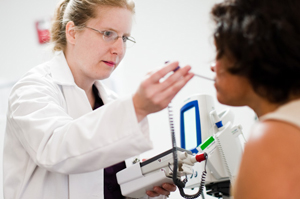 |
Patients experience more frequent visits with a team of health care providers under the medical home model of care. Medical home proponents say this leads to significant decreases in the cost of health care. |
What this creates, Tom Tape, M.D., said, is incentive to physicians and other providers to increase the number of services they perform on patients.
“The more one does, the more reimbursement is received, but only during a face-to-face visit, not working behind the scenes to improve patients’ health,” said Dr. Tape, chief of general medicine at UNMC. “We want to change that.”
The solution: The medical home
The method by which he would like to enact this change is called the “medical home model,” a team-based approach to health care that focuses on prevention and disease management.
Last fall, Dr. Tape and Lynell Klassen, M.D., chairman of internal medicine at UNMC, implemented the medical home model at the UNMC Turner Park Clinic — a resident-run clinic in Omaha.
The medical home model includes a team typically composed of:
- A physician, who serves as team leader;
- A nurse;
- A pharmacist;
- A psychiatrist;
- A social worker;
- A nutritionist; and
- A physical therapist.
Maintenance of health becomes priority
Using the model, the patient visits the clinic more often and meets with appropriate team members to set plans and steps aimed at maintenance of good health.
“It’s what patients think their health care provider should be doing for them, but the current health care system isn’t well designed to meet those patient expectations,” Dr. Tape said. “It seems as though all one can do is see and treat patients walking through the door and we never find time to do the sorts of things that will lead to long range health. We’re putting out fires of sorts.”
Reimbursement changes needed
The medical home model, however, would require changes in how health providers are reimbursed.
There are some established medical home models across the country that receive extra reimbursement for their team-based, whole-patient approach, but the Turner Park clinic receives no extra funding for its medical home model, Dr. Tape said.
Paying the team
There are a number of thoughts on how a reimbursement system should work for the medical home model and most include a monthly payment to practices for each enrolled patient to cover the expenses of chronic care management and wellness promotion.
A key issue is deciding how to reimburse each member of the team, said Rob Schwab, M.D., assistant professor of internal medicine and director of the Turner Park medical home project.
Based on the patient’s issues, he or she may only see some team members and never visit others. Many times physicians will not need to actually see the patient as other team members can deal with the issues.
Medical home can reduce costs
While a reimbursement system for medical home care is needed, if properly implemented, Drs. Schwab and Tape said the medical home model significantly would decrease the overall cost of health care.
“We need government agencies and insurance companies to buy into this,” Dr. Schwab said. “If we do a better job, everyone should save money.”
Dr. Tape used the example of a patient with poorly monitored diabetes who needs a leg amputated — a procedure that costs the health care system about $30,000.
“You can do a whole lot of preventive care for $30,000,” Dr. Tape said.
This preventive care can take place in a medical home environment where the disease can be monitored and education can be provided to help patients better care for themselves.
“Not only would patients be grateful, but it would save a lot of money for the health care system,” Dr. Tape said.